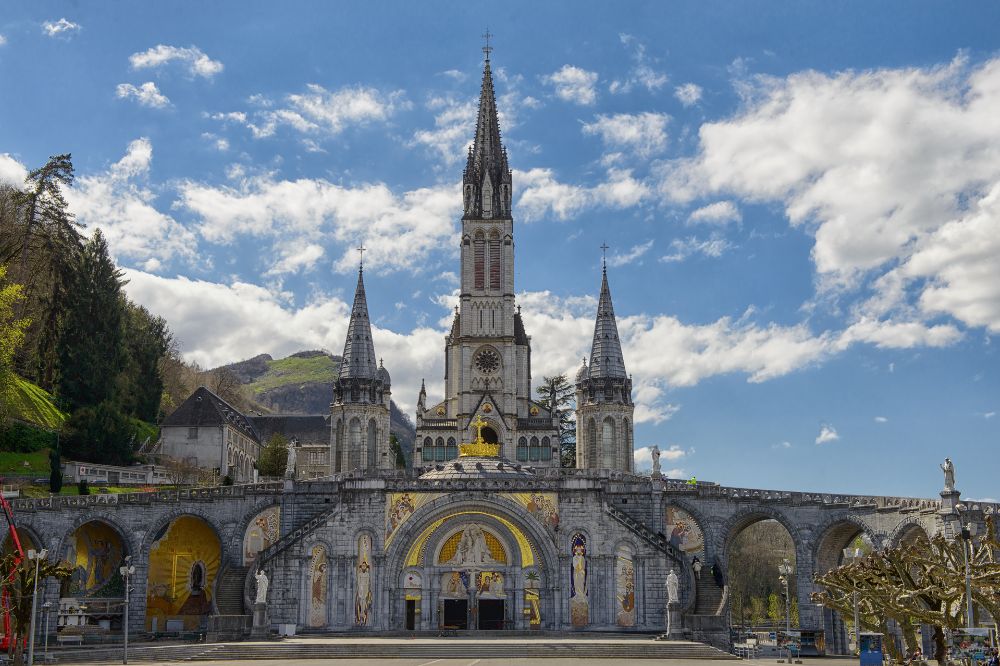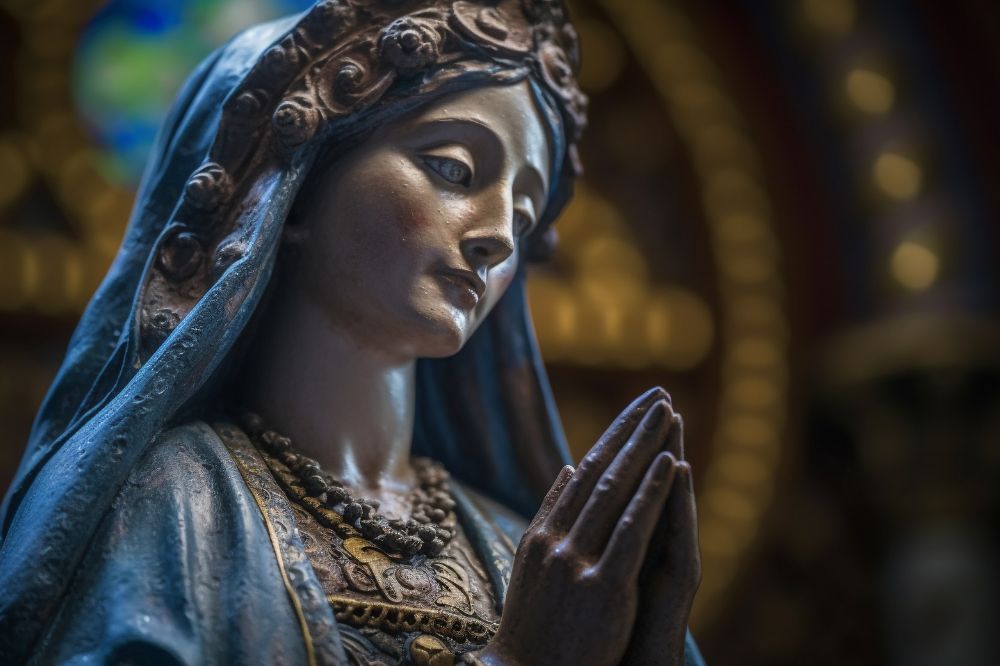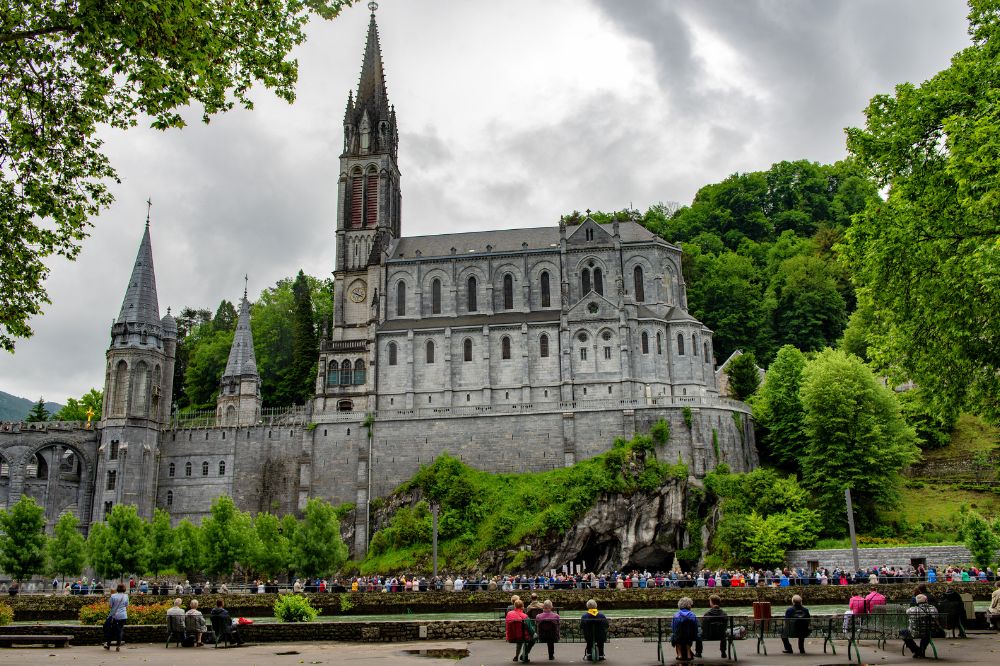
In the southwest of France, nestled among serene hills, lies Lourdes, a place of profound spirituality and renowned healing. This sanctuary, one of the most visited in the Christian world, holds a history that transcends time and space, inviting the faithful on a journey of faith and healing.
In 1858, the tranquil town of Lourdes was transformed by the visions of Saint Bernadette Soubirous.
She was a humble young girl whose encounters with the Virgin Mary revealed the existence of a previously unknown water source. According to accounts from that time, this water miraculously emerged at the foot of the Massabielle grotto and soon became a symbol of purification and miracle for those seeking relief and comfort in its waters.
The Virgin of Lourdes, venerated as a mediator of grace and healing, has inspired millions to embark on a pilgrimage filled with hope and spiritual quest.

The devotion to the Virgin of Lourdes is a phenomenon that has captured the imagination and faith of millions around the world. It can be considered one of the Marian sanctuaries in Spain and among the most important in all of Europe. Yes, although it is in France, it is a Pyrenean locality near the Foral Community of Navarre.
This place has become a central destination for pilgrimages, where the faithful seek physical and spiritual healing.
On February 11, 1858, in a small grotto near the Gave river in Lourdes, Bernadette Soubirous, a fourteen-year-old girl, experienced the first of eighteen apparitions of the Virgin Mary. This encounter marked the beginning of a series of visions that would have a profound impact on the religious history of the place.
During her first vision, Bernadette described seeing a lady dressed in white, with a blue sash and a golden rosary. Although she initially did not know who she was, the presence of the lady filled Bernadette with an immense peace and happiness.
In subsequent apparitions, the “lady” instructed Bernadette to return to the grotto for fourteen days. It was during these visits that messages of prayer, penance, and the request to build a chapel on the site were revealed.
The most significant apparition occurred on February 25, when the Virgin asked Bernadette to dig into the ground of the grotto, where a spring of water emerged. This water soon became known for its healing properties, attracting pilgrims from around the world.
On March 25, she appeared for the sixteenth time. On this occasion, Bernadette repeatedly asked who she was, and finally, she responded that she was the Immaculate Conception.
Initially, the Church’s reaction was one of skepticism, especially given Bernadette’s humble circumstances and the extraordinary nature of her claims. However, after investigations and the growing wave of testimonies of healings and conversions attributed to the apparitions, the Church began to view these events differently.
In 1862, the Bishop of Tarbes, Laurence, declared the apparitions as “worthy of belief” and authorized public worship in Lourdes. This declaration not only affirmed the veracity of Bernadette’s visions but also allowed Lourdes to develop as one of the world’s principal Marian pilgrimage centers.

The discovery of the spring occurred on February 25, 1858. During one of the apparitions, the Virgin asked Bernadette to dig into the ground at a specific spot in the grotto and drink from the spring she would find.
At first, there was only mud, and Bernadette began to eat it, which caused onlookers to mock her. However, shortly afterward, clear water emerged, and over time, this small spring became the famous center of the healing waters of Lourdes.
Since then, numerous testimonies of miraculous healings have been reported. People from all over the world have shared stories of inexplicable recoveries after using the water, either by drinking it or bathing in it.
The Church has investigated many of these healings, officially recognizing more than sixty as miracles. These testimonies have helped cement its reputation as a place of genuine miracles and have reinforced believers’ faith in the power of divine intervention.
For those visiting Lourdes with the hope of experiencing the healing properties of its famous spring, there is an established protocol to maintain solemnity and respect in the process.
Upon arriving at the sanctuary, pilgrims can approach the spring to collect water from the available taps, which are supplied directly from the spring. Many choose to bring bottles of water to take home as a sacred keepsake or to share with loved ones.
The ritual baths in Lourdes are an integral part of the pilgrimage experience. These take place in special pools, where pilgrims are briefly immersed in the cold water, often as part of a directed prayer or meditation.
It is advisable to wear comfortable and easy-to-remove clothing, as changing rooms are provided where volunteers help pilgrims prepare for the rite. This act of immersion seeks not only physical healing but also spiritual renewal, symbolizing an act of faith and trust in the protection of the Virgin Mary.

The Sanctuary of Our Lady of Lourdes has become one of the world’s most significant pilgrimage sites. It is similar in importance to other great Marian sanctuaries such as the Sanctuary of Fatima (Portugal) and the Sanctuary of Guadalupe (Mexico). Composed of several structures and sacred areas, each element has its own history and spiritual significance.
The main structure of the sanctuary is the Basilica of the Immaculate Conception, which majestically stands on the rock above the Grotto of Massabielle. This basilica was built in response to the growing number of pilgrims and was dedicated in 1876. Its elevated position offers a panoramic view of the sanctuary complex and the Gave river.
Just below, we find the Basilica of the Rosary, characterized by its impressive façade decorated with mosaics depicting the mysteries of the rosary. Inaugurated in 1901, it is notable for its circular design and domed roof, which provides exceptional acoustics for the prayers and songs of the faithful.
The Basilica of Saint Pius X is one of the most modern structures and was one of the first basilicas built underground in the world. Inaugurated in 1958, on the centenary of the apparitions, it has a capacity of up to 25,000 people. It is specifically designed to accommodate the large groups of pilgrims who visit Lourdes.
Meanwhile, the Massabielle Grotto is the heart of the sanctuary, the exact place of the Virgin’s apparitions to Bernadette. This simple cave houses the miraculous spring and is a place of profound veneration, where the faithful light candles and leave prayer requests.
Additionally, there are several other important sites within the sanctuary:

The sanctuary of Lourdes offers a wide variety of events and regular liturgies that reflect its role as a center of Marian spirituality. Every day, multiple masses are held in different languages in the various basilicas and chapels of the sanctuary, allowing pilgrims from around the world to participate in the Eucharist.
Processions are an integral part of the sanctuary’s life. The Torchlight Procession stands out each night, where thousands of pilgrims carry lit candles while reciting the rosary and singing hymns in honor of the Virgin Mary. This procession creates a deeply emotional atmosphere of unity and contemplation.
It also offers regular confession services in various languages, providing pilgrims the opportunity for reconciliation and spiritual renewal. Additionally, Eucharistic adorations and blessings of the sick are organized, emphasizing the message of healing and hope.
Undertaking a pilgrimage to Lourdes is a profound spiritual experience that requires some preparation and planning. Like other major pilgrimage destinations, such as Medjugorje, it is important to consider logistical aspects to ensure a smooth and enriching journey.
Lourdes is accessible through various transportation options, depending on your point of origin.
Lourdes offers a wide range of accommodation options to suit all budgets and needs. Hotels in Lourdes vary from luxury establishments to more economical options. Many hotels are adapted to receive pilgrims and are often located within walking distance of the grotto and basilicas, facilitating access to sites of interest.
For pilgrims seeking a more affordable option, there are numerous hostels and guesthouses offering basic but comfortable accommodation. Additionally, some religious organizations provide lodging at reduced costs or even free for those in need, especially for the sick or those on a spiritual pilgrimage.

The weather in Lourdes can be variable. During the summer, the weather is generally warm, while in winter it can be quite cold. It is advisable to bring suitable clothing for the season and comfortable for walking, as well as an umbrella or raincoat, as rain is common throughout the year.
In terms of spiritual preparation, it is useful to read about the apparitions and the history of Lourdes before the visit. This may include reading books or watching documentaries about the apparitions of the Virgin Mary to Bernadette Soubirous. Participating in daily prayers and reflections can help center your thoughts and emotions for the experience you will live.
Additionally, be sure to bring essential items such as water, snacks, a first-aid kit, and any necessary medications. A small journal or notebook can be useful for recording your thoughts and experiences during the pilgrimage.
Lourdes has established itself as a place where pilgrims can find peace and comfort in times of personal challenge or despair. The story of the apparitions and the miraculous waters of the grotto serve as tangible reminders that we are not alone in our struggles.
The experience of sharing in prayers and rituals with others who have faith, often under difficult circumstances, fosters a sense of community and mutual support. This environment provides a space for personal reflection and spiritual renewal, offering relief and new perspectives amid modern life.
The spirit of solidarity is palpable in Lourdes, especially in how the community and various organizations strive to facilitate the visit of the sick and disadvantaged. Numerous volunteer organizations work year after year to ensure that those seeking healing, both physical and spiritual, can reach Lourdes.
The experience offers more than testimonies of physical miracles; it presents an opportunity for spiritual transformation. Interaction with a place so imbued with faith and prayer can have a profound effect on visitors, inspiring them to deepen their own spiritual life.
Lourdes teaches that faith is a powerful catalyst for change, capable of transforming pain into hope and challenge into opportunity. For people of all backgrounds, it remains a testament to the power of faith and the human capacity to seek and find peace amid the turbulence of the modern world.
The story of Bernadette and the apparitions of the Virgin Mary resonates through generations. It reminds us that ultimately, our search for meaning and comfort can be found in surrendering to something greater than ourselves.
Stay Connected with WayHoly
Discover your perfect pilgrimage and be the first to know about new journeys. By subscribing to our newsletter, you’ll receive the latest updates on pilgrimages, exclusive offers, and spiritual resources to enrich your faith journey.
Don’t miss the opportunity to deepen your connection with God and lead others on their path to spiritual renewal. Join us today and become an instrument of His Will through WayHoly!
“To upload your pilgrimage, please choose one of our plans and create an account, or log in if you’re already a member. Join us in guiding others on their spiritual journey.”